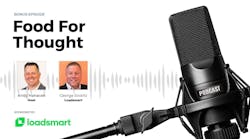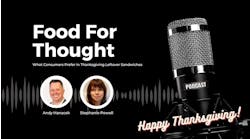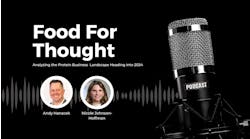George Swartz, vice president of sales for Loadsmart’s Transportation Solutions Group, joins us to discuss the logistics challenges that food and beverage processors face currently, as well as the trends leading operations into the future.
Swartz also offers his viewpoints on how the industry can manage its carbon footprint and reach its sustainability goals through innovative logistics opportunities and tactics. Finally, he gives his thoughts on how and when he believes electric vehicles will start to really impact supply chain and logistics. Listen below and also learn how Loadsmart Managed Transportation can lower freight costs.
Transcript
Food Processing: Let’s talk about logistics for the food industry, food and beverage. What are some of the logistics issues that are plaguing the food industry today?
George Swartz: I think you’ll see there are a lot of general logistics issues that are plaguing all of transportation and logistics. There’ll be some that we will talk about that are specific to food, but some of the general ones we’re running into right now are, we’re starting to see tightening in the transportation marketplace. Again, from a capacity standpoint, that’s always an issue. When you think food, you start to think specialized equipment as well, because you’re looking quite often at refrigerated or frozen needs — trailers and delivery trucks, etc. Those are in even shorter supply.
I think one of the things we’re seeing, too — and it’s a post-Covid phenomenon more than it was prior — but we’re seeing a lot more smaller, more frequent shipments. So shippers that used to be shipping truckloads all the time are now looking at LTL, or less than truckload. And when you start to look at temperature controlled, for example, there aren’t nearly as many choices from a temp-controlled LTL standpoint. What that does, it forces new capabilities, the ability to optimize, the ability to combine orders or combine shipments to try to get back to truckloads or back to truckloads with stop-offs.
That requires some tools, that requires some expertise. And it’s not a situation where a lot of companies have that. Even if they’ve got a decent transportation management system, they may not have the optimization capabilities with it. There are tools that do obviously, but then not everybody knows how to use them from that standpoint as well.
If you add to that what we’re seeing in the supply chain and logistics marketplace, there aren’t as many Gen Zers and Millennials going into the field as there were with Gen Xers and Baby Boomers. And that’s creating another kind of shortage that we had thought about, in planning and management personnel in the supply chain logistics area. So those things combine to make it kind of a difficult situation put on top of it.
Then the economy and a lot of disruptions in the supply chain — some that were foreseeable, some that weren’t — that puts even more stress on the whole logistics system and the need to be able to get ahead of this stuff and manage it. Companies are often turning to organizations like Loadsmart, where we can provide managed transportation solutions, and there’s a number of companies out there other than us that do that kind of work. It allows you to get at the optimization capabilities to be able to supplement your team, or as your team starts to retire or moves up within the organization, you don’t have to backfill. You can utilize a managed transportation solution to be able to close that gap. So it’s getting creative and there’s a lot of things going on. But those are some of the issues that we’re seeing from a logistics standpoint.
FP: You mentioned post-Covid … are these issues new to the industry or were they kind of rearing their ugly heads in a sense prior to Covid, and maybe Covid exacerbated them or maybe made them less of an issue? How does the landscape compare now when it comes to these issues versus pre-Covid?
Swartz: Let’s talk about shifting to smaller, more frequent orders, increases in LTL that was already going on. It was starting to be an issue for shippers, especially on the food side. Covid was really an accelerator. When you think about what we went into, the amount of consumer buying that went on and the changing of distribution networks, having to turn on a dime. It really was an accelerator. So I think that was the big Covid impact. You also had exceptional demand during Covid because everybody was home. If you weren’t going out, you weren’t going and doing your normal leisure activities, etc. So you were shopping online, you were ordering your food and having it delivered. I think it helped companies like Instacart and others like DoorDash and those kind of delivery services. I think they blossomed and exploded during that. And frankly, a lot of them couldn’t keep up with the exceptional demand.
Now we’re on the back side of that demand curve. Things have smoothed out, but the world’s never going to be the same as it was pre-Covid. It accelerated not returning to the office. It accelerated the whole expectation around instantaneous fulfillment and people’s standards changed. And it’s funny, we’ve seen it as these two generations move into more management positions and decision-making positions. They grew up in this instant-gratification kind of marketplace, and they expect that of suppliers and providers in the workplace as well. You’ve had a number of things coming together here to change the landscape, pre-Covid to post-Covid. Now we’re returning to normal, but we’re seeing a lot more micro-fulfillment, smaller fulfillment centers closer to the market, which means replenishing. Those are smaller orders coming in, and that’s changed the landscape of what food and consumer packaged goods companies are dealing with.
FP: So you kind of got into a little bit of the trends coming forward with logistics and networks for food and packaged goods. What other trends are you seeing out there?
Swartz: I think you’re going to see a lot more emphasis, even more than before Covid, on last mile delivery and getting closer to the marketplaces. As I was alluding to, you have a lot of companies that are investing in micro-fulfillment centers. They’re also incenting people to do the last mile delivery themselves and go and pick things up. So they order online, take advantage of the technology, but then eliminate the need for the last mile delivery because they’re willing to go pick it up yourself. The old “order online, pickup in store” has become a reality, and I think we’re going to see more of that. I think you’re going to see traditional retailers, food and other categories, start to move a lot more to turning their retail outlets into fulfillment centers. I mean, Whole Foods has been going through this iteration for probably two to three years now, designating a certain amount of their store. You’re seeing other grocery chains designate certain parts of their store as fulfillment now. So there are many warehouses and creating micro-fulfillment centers — all of those kind of change the landscape on how I think about transportation, how I think about placing inventory, and the frequency and the duration of transportation that I can tolerate in that kind of marketplace.
FP: Let’s discuss the role of private fleet assets. Should shippers consider private fleet assets versus dedicated carriers versus brokerage?
Swartz: The interesting thing with private is, companies still do it, and there are reasons to do it. But you’ve got to look at, am I getting my bang for my buck with a dedicated service or with a private fleet? And where I’m going there is, if that fleet is utilized, maybe it’s utilized 30% of the available hours for that equipment, then am I getting the bang for the buck with my investment in this? And consider not just the investment in equipment and paying of a driver, but now I’m taking on extra liability because I’m operating a fleet and there’s significant liability that can go along with that. And then I’ve got other costs, maintenance, replacement depreciation, all those things. You’ve got to think like a trucking company and you have to look at it really, is this at least a break even proposition for me, or am I going to lose money if I’m going to run this private fleet? So that’s the big question mark. Now, running specialized equipment, smaller equipment, maybe box trucks or vans versus tractor trailers, there may be a good justification for that. And I can get all the utilization I need out of a last mile delivery fleet to do those sort of things.
Dedicated contract is kind of the hybrid between owning my private fleet and going to a common carrier or brokerage to get my transportation. Somebody else is still taking on the onus of making sure that fleet is utilized. They’re doing the planning, they’re doing the driver management, they’re trying to get the most utilization out of it. So you get the benefits of that private fleet, but you don’t have the onus on you for all of the utilization, for all of the maintenance, the liability, etc. And there are many people who still think it’s great to have a rolling billboard to be able to have my name and my products advertised on the side of a truck. But I’ve got to weigh that against the costs associated with it.
Then finally, brokerage and common carrier. The issue there is, rather than being in a fixed cost situation and having to bear and brought all the costs, I’m able to manage my transportation costs a little tighter. I’m able to react to the market. If you look at the shifts that have happened in common carriage management today, it used to be that a company would go out, do an annual bid, award contracts in lanes, lock their rates in for a year. Now it’s much more common to see quarterly bids, and many bids and many RFP and spot buys, so that I can take advantage of what’s going on with the market. Now, there’s some risk and downside to that as well, because if you catch the market on the upswing and you didn’t have contract plate rates in place, you can suffer from that. But many companies who were locked into annual rates missed the whole last year when transportation rates dipped significantly and companies who were a little more agile saved a lot of money on those rates.
FP: Shifting gears to sustainability, put on your expertise hat here and offer listeners some tangible ways that they can manage their carbon footprint when it comes to their logistics program.
Swartz: I think there are a couple of things. One, there’s managing your current carbon footprint and then there’s a little bit of a look to where are we going from a sustainability standpoint. What’s the near future? Today, some of the best things that you can do is the optimization we were talking about earlier. Any time I can combine orders or shipments into a full truckload and I’m only running that one truck, I’m not going through a hub and spoke network now like I might have been with an LTL shipment. I’m saving miles. We just did an analysis for one of our clients that we had shifted quite a bit of their LTL into truckload or truckload with stop-offs, and we were able to save them 300,000 miles on the year. That’s significant when you think about the carbon footprint associated with those 300,000 miles in terms of fuel, emissions, fuel necessary to run the reefer. Also, clients that are running refrigerated freight, if you want to be more sustainable and you have products that don’t have to be refrigerated. by separating those and getting them into other truckloads, you can reduce the dependance on the refrigeration unit, which again uses fuel, creates emissions, etc. So those are some of those are some of the big areas.
Another one that I think is a great one for companies to think about — and they usually don’t think about it as much from a sustainability standpoint — but if I can mode shift, take my truckloads and put them on intermodal and have them go via rail for the lion’s share of the of the line haul, I’m saving there as well from a carbon footprint standpoint because I’m not operating those individual trailers; they’re going on a train. And while there is still emissions and there’s still carbon footprint associated with rail, it can it can be much lower than all of those trucks on the road.
So those are some of the things I think that you can do today to be very sustainable or help with sustainability. The other one is watching idling time, getting trucks in and out of the dock quickly so they’re not sitting there running and burning fuel. That’s more of a dock management, less on the transportation side. One of the things that’s going to help here: I think you’re going to see commercial trucking … electric vehicles sooner than you’re seeing passenger vehicles and their uptake. As soon as the technology is ready, I think you’re going to see heavy adoption for a number of reasons, not the least of which is the driver shortage we’re dealing with. It’s going to be easier to drive and easier to train people on an electronic tractor trailer or cargo vehicle than it is on today’s versions of that same equipment. And that’ll help us, I think, attract more drivers, etc.
FP: I’m glad you mentioned the electric the electric vehicles. Out of curiosity, how far down the road do you do you see this happening? Is this more of a pie in the sky, Jetsons-like idea right now, or is it right on the horizon?
Swartz: I think it’s right on the horizon, and I think you’re going to see it come in the smaller vehicles, because you’re seeing several companies now that are developing and getting into partnerships on the cargo vans — the larger, Sprinter-type sized van that you see Amazon and others use today. You’ll see that translate into bigger cargo vehicles. The biggest thing is solving the battery and how much time can I get out of a charge with that large piece of equipment. But I think they’re making strides in that. I think we’re within a decade of seeing some very tangible results in this space and starting to see more and more this equipment start to convert over.
FP: Before I let you go, George, can you describe for our listeners the managed transportation offerings by Loadsmart?
Swartz: With Loadsmart, we offer a number of transportation management solutions. Our Managed Transportation group offers basically anything you would need from a transportation standpoint. We can come in, augment your team or become your team and manage everything from carrier sourcing and procurement on the front end — which includes all of the bids and spot buys and all the things you would normally have to do — the full planning side of things, including optimization with the tier one optimization engine and all of your load planning, route planning.
We’re taking out all of that full transportation execution and that’s receiving orders, assigning carriers, tendering the loads, doing the track and trace, and visibility portion of it as you monitor the shipments on the outbound, confirming deliveries, expediting it where needed or doing exemption based management and all the way through freight audit and payment.
We can even take on your contracts as a shipper, we’ll put them on Loadsmart paper and we will handle paying the carriers and then just bill you back for what those charges are. So there’s a number of things that we can provide.
The other thing is any of those discreet processes — let’s say that you have a transportation management team but you don’t have optimization capabilities — we can do planning as a service. So we would take your orders on a daily basis, optimize them, develop your order and load consolidations and your load plans, feed those back to you, guide you, and then you could execute on it.
It’s very customizable depending on the client’s situation. So you don’t have to be looking to outsource all of transportation to take full advantage of Managed Transportation and services. But for people that would like to do that, know we’re capable of doing that as well. The one thing about Loadsmart, we are a technology-enabled managed transportation service, we’ve got a number of proprietary software tools and transportation management tools that we bring to the table when we come in for a client.
Also, just to kind of go off that path a little bit, there are clients who just want the tools, and we have a digital team, where we have SaaS offerings to be able to do your own sourcing and procurement, your own freight payment audit and other things. So there’s a number of ways that we can put things together. But at the end of the day, you know, Loadsmart Managed Transportation is your end-to-end transportation services provider, and we customize it to your needs.




